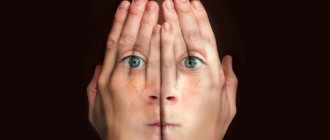Anxiety depressive disorder symptoms and signs
Since depressive disorder has acquired the status of a modern international problem, a whole classification of symptoms and signs has been compiled in medicine. It is important to note that we can only talk about a disorder if a person has symptoms on an ongoing basis for at least 1 month. To make a diagnosis, as a rule, 4-5 signs of the following must appear:
- Difficulty concentrating. To solve at least one task, a person has to make enormous efforts, since increased absent-mindedness prevails
- Lack of a normal sleep cycle. Sleep does not occur immediately; intermittent sleep is often observed (waking up after a short period of time), resulting in constant fatigue.
- Feeling as if strength is leaving the body. As a rule, with increased attention, the patient begins to feel anxiety and irritation.
- Increased irritability. Most often it manifests itself in an ordinary reaction to external stimuli in the form of tears, screams, even if the person is asked an ordinary question
- Groundless worry. Accompanied by a feeling of unreasonable fear and lack of self-confidence
- A tearful state. The patient begins to cry under any circumstances: observing a touching moment, an ordinary meeting with friends and relatives
- The emergence of unfounded fears. Any event, even one without any danger, seems suspicious to a person
- Constantly prepared for the worst. The patient develops a strong belief that the future does not promise him anything positive and the situation will only get worse every day
- A state of hopelessness. When any action seems completely ineffective, luck has turned away from the person and one should not hope that something good will happen in the future
- Low self-esteem. As a result, one’s own importance is devalued.
Any of the symptoms must be present for a month to indicate the occurrence of a depressive disorder.
Literature
- Karavaeva T.A. Principles and algorithms of psychotherapy for anxiety disorders of a neurotic level // St. Petersburg Psychoneurological Research Institute named after. V.M. Bekhtereva", 2016.
- Generalized anxiety disorder: clinical recommendations // Developer of clinical recommendations: Russian Society of Psychiatrists, 2015.
- Zabylina N. A. Issues in the diagnosis of mixed anxiety and depressive disorder // Journal of Siberian Medical Sciences, 2008.
- Shitov E. A. Neurotic and somatoform disorders: guidelines for students in the discipline “Psychiatry” // State Budgetary Educational Institution of Higher Professional Education Ryaz State Medical University of the Ministry of Health of Russia. – Ryazan: RIO Ryaz State Medical University, 2013.
Treatment of depressive and anxiety disorders
The selection of treatment is carried out depending on how severe the patient’s condition is and what are the causes of the disease. As a rule, a combination of medication and psychotherapeutic treatment is selected.
The goal of drug therapy is to reduce anxiety levels. Tranquilizers or antidepressants may be prescribed individually. It is important to note that the dosage and choice of the drug should be carried out exclusively by the attending physician in order to prevent the situation from worsening. Important: in the case of the development of anxiety-depressive disorder and the use of psychotropic medications, the situation can lead to suicide.
In practice, one of the most common drugs is Phenazipam. However, its effectiveness is noted only with the correct selection of the daily dose and duration of use. The main effect is the rapid elimination of sleep problems and increased levels of anxiety. It is strongly not recommended to change the dosage or stop taking medications on your own.
Innovative medications allow use in outpatient settings when using small dosages.
Monitoring and preparing a proper diet rich in all necessary vitamins is the second step to improving your condition. These categories include:
- Eggs, beef, tomatoes, cheese and bran, which contain a storehouse of vitamin B
- Sunflower seeds, parsley, onions, beans are sources of folic acid.
- Carrots, apples, buckwheat contain large amounts of iron
- Currants, sauerkraut, rose hips contain a sufficient amount of vitamin C.
To stabilize the functioning of the autonomic nervous system, a variety of physiotherapeutic techniques are used. A wide variety of massages are provided (firming, toning, relaxing, healing). With appropriate skills, a person can achieve harmony with his state of mind and body.
Electrosleep is often used in practice, which helps stabilize not only the general physical condition, but also optimizes the processes occurring in the cerebral cortex. The procedure allows you to put the patient into deep sleep, which helps to relax the body, exhausted by constant phobias and feelings of fear.
If a person does not receive enough oxygen, oxygen therapy is used. The patient is placed in a special chamber where oxygen saturation occurs. Allows you to maintain and strengthen immunity at the proper level.
It is impossible to cope with this disease without the work of psychotherapists. Typically, specialists use cognitive behavioral methods, which have been known to be effective for many years. Errors in thinking are also discovered, and a person learns new adequate reactions to current events. The patient gains valuable experience and learns how he should behave if a traumatic situation arises.
As a result, a person begins to receive positive emotions from his own life. At the same time, drastic changes should not occur in order to enjoy the simplest things (sun, good weather or birdsong).
Psychotherapists often use role-playing, which helps set him up to return to society as a full-fledged member of it, without experiencing a strong shock.
Diagnosis of depression
Treatment of depression is the sphere of activity of a therapist, psychologist and psychiatrist, optimally their collegial cooperation. Special questionnaires and complaints from patients and their relatives about characteristic changes in well-being and mood make it possible to recognize the signs of depression and make an accurate diagnosis. In personal communication with the patient, the doctor clarifies the duration of the disease, and also delicately clarifies the emergence of possible thoughts about causing harm to himself or others. Also, concomitant pathological conditions are subject to mandatory study: tendency to use alcohol and drugs, smoking, excessive eating, etc.
Of great importance is the differential diagnosis of depression, which makes it possible to distinguish this disease from other similar mental pathologies: bipolar disorder, anxiety, demoralization, signs of dementia or hormonal disorders associated with dysfunction of the thyroid gland. At the same time, a number of clinical examinations are carried out: a general blood test, measurement of thyroid hormone levels, electrolyte balance, and the content of prohibited psychotropic substances in the blood.
Types of Depressive Disorders
There are many classifications of depressive disorder, but among the most common there are several types.
Anxiety-depressive disorder
Neurotic disorders that manifest themselves with multiple symptoms. Despite the psychogenic nature of the formation, the individual’s personality remains intact. The person understands what is happening, which is why he experiences strong feelings and anxiety.
The formation of the disease is based on a depressive state and an increased level of anxiety. At the same time, it is impossible to form a specific assumption about which condition manifests itself in a more pronounced form. One can only conclude that at the level of progressive depression, anxiety will increase. Often anxiety begins to develop without any clear reasons.
Unmotivated aggression often appears as a concomitant factor. A large number of hormones responsible for the formation of stress enter the blood: cortisol, adrenaline. They often create a desire to run away, to hide from the outside world. Against the background of the disease, the following symptomatic manifestations can be distinguished:
- Periodic dizziness and pain
- The patient clearly hears every heartbeat
- The occurrence of oxygen deficiency
- There is a dry mouth and a lump in the throat.
The above characteristics also bring physical discomfort, which only makes the situation worse.
Recurrent depressive disorder
This is a type of mental illness that can result in recurrent episodes of depression in varying degrees of severity. In practice, it most often develops in middle-aged people 35-40 years old. As a rule, the precursor to recurrent depression is injury or the development of other central nervous system diseases.
Often acute periods appear at certain intervals from 3 months to a year. As a rule, each patient can track his own rhythm. When the condition improves, the person begins to live normally again, as if the disease did not exist.
As for specific signs, they do not exist for recurrent depression. As a rule, there are sharp jumps in the emotional background, and the mood drops sharply. The average time for a patient to feel normal is no more than a couple of months.
Manic depressive disorder
MDS (manic depressive disorder) is a serious type of mental disorder characterized by a sharp change in emotional background, ranging from severe depressive attacks to the onset of euphoria and excessive arousal. However, remission periodically occurs when the clinical picture stabilizes and side symptoms do not appear at all.
As a rule, people over 30 years of age are included in the MDS development group. Most often, these are people prone to melancholy, suspiciousness and emotional instability. In females, exacerbation most often occurs during menstruation, after labor or at the onset of menopause.
Depressive disorder symptoms
Symptoms vary depending on the type of depressive disorder. However, three groups of signs can be distinguished that are common to all types of disease:
- Emotional aspect. Mood swings are observed, apathy and irritation appear, interest in favorite work activities is lost, and the person tries to avoid contact with loved ones. Often a person may completely lose the ability to express emotions: love, hatred, compassion
- Behavioral. Disclaimer of liability for any event. A person tries to lead a secluded lifestyle, stops communicating even with the closest people, physical activity drops rapidly, and difficulty concentrating is observed.
- Physical. Manifestations of the somatic type are often expressed in rapid fatigue, weakness, loss of appetite, and a person constantly feels tired.
Major depressive disorder
A distinctive feature of MDD is the formation of a stable decrease in the emotional background. The patient lives most of the time in a bad mood, with low self-esteem, and ceases to feel interest and desire to engage in usual activities, activities or hobbies.
It has a negative impact on all areas of human activity: study, family life, professional sphere, communication with other members of society. The most common category of patients are people aged 30-40 years.
Mixed depressive disorder
A mixed type of depressive state is characterized by the manifestation of anxiety and depression in equal proportions. Along with an unstable emotional state, we can talk about physiological manifestations, since mood decreases, anhedonia develops, and interest in the course of one’s own life disappears.
According to statistics published by WHO, the total share of mixed diseases is 5% of the total number of depressive conditions.
Bipolar depressive disorder
It develops quite rarely. Bipolar depression belongs to the manic group of disorders and is characterized by a complex mental state of the patient. It is important to note that heredity plays a significant role in the occurrence of this disease.
A distinctive feature of the disorder is a sharp change in the emotional background. For example, a person may experience despondency and irritability, and after a while a feeling of euphoria sets in and an excellent mood prevails.
Prevention
The best “soil” for neuroses and depression is a poor psychological climate in the family, at work, and the lack of a healthy balance of neuropsychic and physical stress.
There are no specific preventive measures for neurosis. If you take care of your mental health and adhere to a healthy lifestyle, even if you have a genetic predisposition, a mental disorder will not become active. General recommendations:
- engage in education on the topic of mental health, neuroses and depression - this is important for developing the ability to identify mental pathology in a timely manner;
- have a hobby that helps you take your mind off stress for a while;
- adhere to a normal work-rest, sleep-wake schedule;
- if there are family conflicts, contact a psychologist for their timely resolution;
- It is not recommended to close yourself off from people too much - you should at least sometimes spend time with friends, visit clubs of similar interests;
- prevent traumatic influences at work and in the family.
Prognosis for depressive disorders
If the patient continues the course of treatment properly and follows all the specialists’ instructions, the prognosis is very favorable. It is important to note that in 50% of cases, patients show independence and stop taking medications, without fully curing depression. As a result, a relapse occurs, which worsens the patient's condition.
It is extremely important to stop the disease after the first manifestation, otherwise the likelihood of reoccurrence increases. After repeated onset of depression, a third attack occurs in 75% of cases.
Frequently asked questions about depression
How to get rid of depression on your own?
Attempts to deal with depression on your own usually end in failure and the appearance of signs of a deeper disorder. Only an experienced doctor will be able to determine the type of disease and select the optimal treatment tactics. Folk remedies, uncontrolled use of antidepressants “on the advice of friends,” withdrawal into oneself only tighten the problem and can cause deeper mental disorders with a simultaneous deterioration in physical health.
Why is depression dangerous?
Voluntary refusal of treatment with the intention of independently overcoming the disease can have the most severe consequences: the appearance of suicidal thoughts, deep mental disorders, increased frequency of attacks, personal degradation in professional and family terms, and the emergence of addiction to alcohol and drugs. It is useless to treat all of these symptoms with conventional treatment methods, and taking potent drugs can cause side effects.
How to overcome depression?
It is important to understand that depression is not a temporary deterioration in mood, but a serious mental disorder. And it will be possible to cope with it only after completing a course of complex treatment with the mandatory use of prescribed medications and additional methods for correcting the psycho-emotional state. Treatment under the supervision of an experienced specialist will help to completely cope with the disease and reduce the risk of relapse even when exposed to negative factors.
Possible complications
Why is a depressive episode dangerous? If left untreated, this condition can easily degenerate into one of the social phobias: fear of being in a crowded place, fear of losing a loved one, becoming unwanted. Such decadent moods sometimes lead to suicide or attempts to commit suicide or harm oneself in every possible way.
In the absence of treatment, some patients try to find a solution in alcohol, drugs, excessive smoking, or an independent decision to take sedatives or even psychotropic medications.
Causes of the condition
Let's look at what can cause the development of a depressive episode. Among the most likely reasons, experts identify the following:
- Genetic. These are abnormalities affecting the eleventh chromosome. However, polygenic types of the disorder are also noted.
- Biochemical. The cause of the condition will be a violation of the activity of neurotransmitter exchange. In particular, this is a deficiency of catecholamines and serotonin.
- Neuroendocrine. A moderate depressive episode can be the result of disrupted rhythms of the limbic, hypothalamic, pituitary systems, and pineal gland. All this will be reflected in the production of melatonin and releasing hormones. The process is believed to be related to daylight photons. They indirectly affect the complex rhythm of the body, sexual activity, need for food, sleep and wakefulness.









